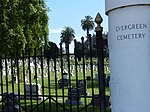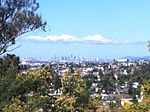California Concordia College existed in Oakland, California, United States from 1906 until 1973.Among the presidents of California Concordia College was Johann Theodore Gotthold Brohm Jr.California Concordia College and the Academy of California College were located at 2365 Camden Street, Oakland, California. Some of the school buildings still exist at this location, but older buildings that housed the earlier classrooms and later the dormitories are gone. The site is now the location of the Spectrum Center Camden Campus, a provider of special education services.The "Academy" was the official name for the high school. California Concordia was a six-year institution patterned after the German gymnasium. This provided four years of high school, plus two years of junior college. Years in the school took their names from Latin numbers and referred to the years to go before graduation. The classes were named:
Sexta - 6 years to go; high school freshman
Qunita - 5 years to go; high school sophomore
Quarta - 4 years to go; high school junior
Tertia - 3 years to go; high school senior
Secunda - 2 years to go; college freshman
Prima - 1 year to go; college sophomoreThose in Sexta were usually hazed in a mild way by upperclassmen. In addition, those in Sexta were required to do a certain amount of clean-up work around the school, such as picking up trash.
Most students, even high school freshmen, lived in dormitories. High school students were supervised by "proctors" (selected high school seniors in Tertia). High school students were required to study for two hours each night in their study rooms from 7:00 to 9:00 pm. Students could not leave their rooms for any reason without permission. This requirement came as quite a shock to those in Sexta (freshmen) on their first night, when they were caught and scolded by a proctor when they left their study room to go to the bathroom without permission. Seniors (those in Tertia) were allowed one night off where they did not need to be in their study hall.
From 9:00 to 9:30 pm all students gathered for a chapel service. From 9:30 to 10 pm, high school students were free to roam, and sometimes went to the local Lucky Supermarket to purchase snacks. All high school students were required to be in bed with lights out by 10:00 pm. There were generally five students in each dormitory room. The room had two sections: a bedroom area and (across the hallway) another room for studying. Four beds, including at least one bunk bed, were in the bedroom, and four or five desks were in the study room
A few interesting words used by Concordia students were "fink" and "rack." To "fink" meant to "sing like a canary" or "squeal." A student who finked told everything he knew about a misbehavior committed by another student. "Rack" was actually an official term used by proctors and administrators who lived on campus in the dormitories with students. When students misbehaved they were racked (punished). Proctors held a meeting once a week and decided which students, if any, deserved to be racked. If a student were racked, he might be forbidden from leaving the campus grounds, even during normal free time School hours were from 7:30 am to 3:30 pm. After 3:30 pm and until 7:00 pm, students could normally explore the local area surrounding the school, for example, to go to a local store to buy a snack. However, if a student were racked for the week, he could not do so.
Proctors made their rounds in the morning to make sure beds were made and inspected rooms in the evening to ensure that students were in bed by 10:00 pm. Often after the proctors left a room at night, the room lights would go back on and students enjoyed studying their National Geographic magazines. Student might be racked if they failed to make their beds or did not make them neatly enough.Although California Concordia College no longer exists, it does receive some recognition by Concordia University Irvine. This is also the location of its old academic records.





